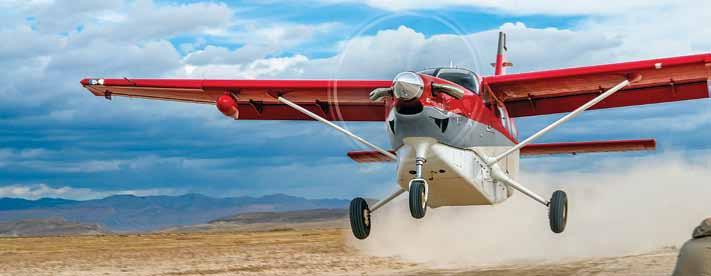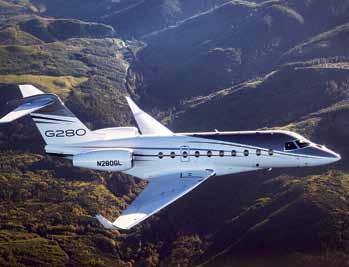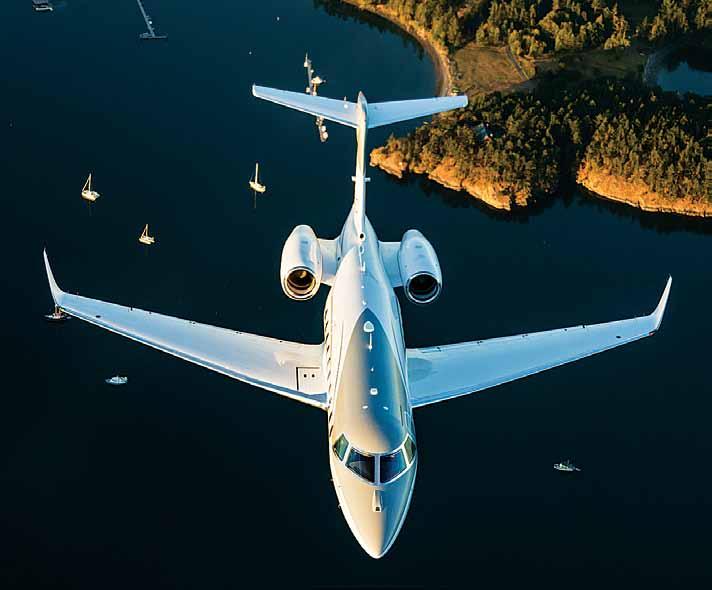
8 minute read
page
a full-size closet. With 100 per cent fresh air, natural light from 19 large oval windows and a low cabin altitude and comfortable seating for up to 10 passengers in the customer’s choice of cabin configurations are G280’s highlights.
EnginEs
Advertisement
The Gulfstream G280 comes with two Honeywell HTF7250G engines, each of which generate 7,445lb of take-off thrust, flatrated to ISA +15 degrees C. The engines are built with dual-channel Fadec, nacelles, and thrust reversers all in an integrated propulsion package.
With a wide-chord damperless fan measuring 34.2 inches (86.9 cm) in diameter, the HTF7000 series has a 4.4 bypass ratio. The engine is part of the HTF7000 family with a dispatch reliability of 99.96 per cent. It incorporates low emissions single annular combustor for emissions reduction (SABER) technology to reduce carbon and NOx emissions.
The HTF7250G propulsion system, environmental and cabin pressurisation control systems, aircraft lighting, SAHRS, auxiliary power unit (APU), and TAWS are provided by Honeywell International.
Flight DECk
The Gulfstream G280 features state-of-the-art Gulfstream PlaneView 280 flight deck that comes with Collins Pro Line Fusion integrated avionics system for improved situational awareness and decreased workload on the pilot. The PlaneViewG280 avionics are a big improvement over the Pro Line 21 avionics in the G200, with three 15-inch (38-cm) displays providing much more screen real estate.
Believed to the industry-leading technology, the PlaneView280™ flight deck, is designed to augment situational awareness, reduce workload and boost pilot efficiency. Similar to the large-cabin jets, the G280 is equipped with auto throttles and the same head-up display and Kollsman enhanced vision system as the G650. The G280 also provides synthetic vision is an option.
The standby multifunctional controllers (SMCs) have many functions, including the ability to manage single-point refueling from the cockpit, instead of having to access the refuel/defuel panel mounted aft of the fueling port. Other functions include PFD settings, weather radar, chart selection, checklists, avionics configurations for each phase of flight, and more.
Overall, the G280 flight deck is thoroughly modern, uncluttered and without too many switches and knobs.
PErFormanCE
The strong performance of the G280, especially the ability to fly coast-to-coast in the United States at Mach 0.84 (3,000-nm/5,556km NBAA IFR range with four passengers) or even farther at Mach 0.80 (3,600 nm/6,667 km, also with four passengers), has been much appreciated by pilots.
The G280 can climb directly to FL430 after taking off at its 39,600-pound mtow. Chief demo pilot Brett Rundle said he has climbed to FL430 in just 20 minutes at maximum weight.
The G280 has a fuel-jettison system, something not found on any other business jets (those that aren’t derived from airline airframes). This system can also be used for defueling via a special adapter that attaches to the jettison port mounted between the flaps and ailerons.
Ailerons are mechanically driven and supported by the multifunction spoilers (the middle and outboard spoiler panels), and either flight control is sufficient for full lateral control. Elevators are hydraulically controlled via dual hydro-mechanical servo actuators, one for each elevator, and each with dual push rods.
The fly-by-wire rudder incorporates a thrust-compensation mode in case of engine failure, and this removes 80 per cent of the rudder pedal force needed to maintain the proper trajectory on one engine.
Weight-and-balance capabilities are generous on the G280. Even with the large aft baggage compartment filled to its nearly 2,000pound (907-kg) capacity, the G280 will stay within its CG limits with no passengers onboard.
The G280 cabin door is electro-hydraulically actuated, an upgrade from the G200’s electrically driven cable and reel system. BAI
mEasurEmEnts
Finished Cabin Height
1.85 m Finished Cabin Width 2.11 m Cabin Length (excluding baggage) 7.87 m Total Interior Length 9.83 m Cabin Volume 26.48 cu m Baggage Compartment Volume Exterior Height Exterior Length Overall Wingspan 3.40 cu m 6.50 m
20.37 m
19.20 m
PErFormanCE
Maximum Range1
High-Speed Cruise
6,667 km Mach 0.84 Long-Range Cruise Mach 0.80 Maximum Operating Mach Number (Mmo) Mach 0.85 Takeoff Distance (SL, ISA, MTOW) 1,448 m Initial Cruise Altitude 13,106 m Maximum Cruise Altitude 13,716 m
1NBAA IFR theoretical range at Mach 0.80 with 4 passengers, 2 crew and NBAA IFR reserves. Actual range will be affected by ATC routing, operating speed, weather, outfitting options and other factors.
WEights
Maximum Take0ff
Maximum Landing 17,962 kg 14,832 kg
Maximum Zero Fuel
Basic Operating (including 2 crew)2
Maximum Payload2
Maximum Payload/Full Fuel2 12,791 kg 10,954 kg 1,837 kg 454 kg
Maximum Fuel 6,622 kg
2Stated weights are based on theoretical standard outfiting configurations. Actual weights will be affected by outfiting options and other factors. Source: Gulfstream
Sustainability in
the Pandemic and Future Growth
By BoBBy Chadha,
Chairman and managing direCtor
SrC aviation Pvt Ltd
This past year 2020 has been a significant challenge for General Aviation industry. The Business Aviation sector usually benefits from times of disruption because business travellers turn to private charters to fill the gaps left by restrictions on commercial aviation. But this time the Industry has been severely affected because countries have completely locked down international travel. Overall global business, year-on-year is down around 70 per cent.
As a result, many small companies have shut down operations. Those who ran a lean operation with low fixed overheads to revenue, and companies that were able to adjust business plans to alternative verticals, have managed to adjust their business model and survive. And while it is hard to predict the decisions of governments in different countries, we now have a better understanding of the risks associated with this virus, and given the widespread and deep economic hardship caused by the lockdown it does appear that countries are beginning to open up.
November and December have seen large increases in charter traffic as demand grows for holiday travelling to exotic resort locations. In South Central Asia, places like Maldives, Seychelles, Goa etc. have benefited from a rapid increase in charter flights. It is our belief that as global companies ratchet up production to meet a rapidly increasing demand for goods and services, business aviation will expand rapidly and could potentially have its best year in 2021.
I also feel that with the need for physical distancing new flyers will enter the private aviation market. Corporate executives are more likely to shun commercial aviation and crowded airports for the safety of private aviation. This has the potential to significantly expand the overall market size.
Service companies related to Business Aviation will have to adjust their business models to meet the increased needs for safety and the increased uncertainty in their revenue models. New and sudden lockdowns should be anticipated and therefore there is need for service companies to manage their fixed expenses related to workforce. Also, contingency plans must be put in place to allow employees to work from home on tasks that do not involve direct customer dealing. Companies will also have to brain storm new vertical lines of revenue and diversify their business offerings. The ones that are able to best do that will survive. BAI


The process of aircraft ownership is complex and JetHQ team of experts provide personalised service to help clients navigate this by bringing extensive aviation experience and real-time industry insight and analysis to each complex transaction
By ROHIT KAPUR President, JetHQ AsiA Making Aircraft Transactions
Easier Around the Globe
When purchasing aircraft directly from a manufacturer, customers are used to a high level of service and the most information possible. Why shouldn’t buyers and sellers in the preowned market enjoy those same high standards?
That was the conclusion lifelong aviation professional Garett Jerde came to, as well. So, he founded JetHQ (www.jethq.com), bringing together industry veterans and a team of aviation experts and brokers, to make aircraft transactions easier for buyers and sellers. To be the dedicated partner looking out for clients’ interests, every step of the way.
Jerde began as a demonstration and ferry pilot, flying planes from the middle of the United States to Singapore and Scotland to South Africa. After he traded ferrying for the sales side of the business, he saw first hand how unique the needs of clients were from one part of the globe to another. Customers rely on experts who know the local culture, can speak the language and successfully navigate complex regulations.
Chairman Ted Farid’s 50-year career in aviation combined all of those attributes, having served in leadership positions for iconic manufacturers including Cessna, Bombardier Learjet and Hawker Beechcraft. In his decades of work, he built international relationships and broke barriers with new markets in Asia.
Together, Jerde and Farid assembled sales experts who are leaders in their fields, and positioned exactly where they can be of greatest service to clients. That includes Rohit Kapur, President JetHQ Asia, who is familiar in India as the Founder and former President of Business Aviation Operators Association (BAOA). He flew helicopters in the Indian Army for almost 20 years before founding and leading his own aircraft sales company. Rohit is ably assisted by Sanjeev Choudhary, Vice President of Sales, who brings in decades of experience of aircraft sales; having formerly represented Eurocopter, Beechcraft and HondaJet in South Asia.
Bringing a level of trust and acumen in aircraft transactions is what separates JetHQ from other brokers. Because the company has sales specialists all over the globe, JetHQ is able to find the right aircraft for clients to buy and open up entire market places of qualified buyers for those wishing to sell. JetHQ, a member of the International Aircraft Dealers Association, has ramped up its presence throughout the world – including Asia, the Middle East and Africa, and the Americas – to meet its business growth. JetHQ’s unique selling proposition for aircraft sales in India is the fact it is well versed with the local conditions,

Private Jets helP achieving the business goals faster and better






